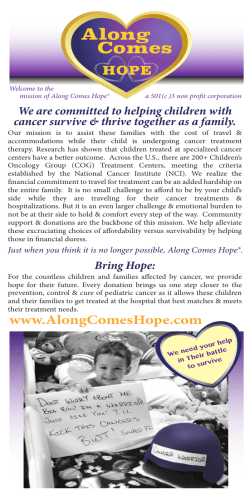
About Donate Life California
Donate Life California Fact Sheet Mission: Donate Life California saves lives by inspiring people to sign up with the state organ and tissue donor registry. Background: Donate Life California is a private, nonprofit entity created to administer the state-authorized organ, eye and tissue donor registry dedicated to saving the lives of thousands of Californians awaiting life-saving transplants. Administered by California’s four nonprofit, federally designated organ and tissue recovery organizations (which facilitate the donation process in the state), the Donate Life California Donor Registry enables Californians to personally authorize the donation of organs and tissue after death. While the vast majority of designated donors enroll through the DMV via their driver license and/or ID card application or renewal, Californians can also enroll online via the Donate Life California website. Structure: The 4 OPOs in California make up Donate Life California: Donor Network West (formerly CTDN) – serves Northern and Central California Lifesharing – serves San Diego and Imperial Counties OneLegacy – serves the seven-county greater Los Angeles area Sierra Donor Services – serves the Sacramento metro area The Donate Life California Board of Directors is comprised of representatives from the OPOs who work in conjunction with the Donate Life California Chief Executive Officer. Quick Facts: In 2013, Donate Life California and the four organ recovery agencies in California coordinated 878 organ donors with 36% of them having made their decision in advance through the state donor registry. This resulted in more than 1,000 lives saved through personal authorization. Since 2005, more than 100,000 lives have been saved or healed through organ and tissue donation as a direct result of the Donate Life California Organ and Tissue Donor Registry. As of March, California has had nearly 12 million people register as organ and tissue donors (more than any other state!). Californians make up approximately 18% of the national transplant waiting list. 3465 Camino Del Rio South, Suite 410, San Diego, CA 92108 • 866-797-2366 • www.donateLIFEcalifornia.org (03.30.15) The Basics About Organ, Eye and Tissue Donation The Basics about Donation • As of November 2014, 123,995 individuals are on the National Organ Transplant Waiting List. 22,088, or approximately 18%, are residents of California. • Nationwide, approximately 21 people die each day awaiting life-saving organ transplants, and a new name is added to the national waiting list every 10 minutes. • One organ donor can save up to eight lives and one tissue donor can improve the lives of up to 50 others. • In California, consent (first-person or by the family) is given in approximately 80% of cases where patients are pronounced brain dead and are medically suitable to be organ donors. Needs in Minority Communities • Nationwide, minorities represent 56% of organ transplant candidates and more than 62% of those awaiting kidney transplants. • In California, Latinos make up 40% of those waiting for life-saving transplants, Asians/Pacific Islanders 20%, and African Americans another 13%. • Nationwide, African Americans comprise 12% of the total population, but represent 34% of kidney transplant candidates due to a higher incidence of diabetes and hypertension. Biology • Organs that may be donated (in order of frequency transplanted) include the kidneys, liver, heart, lungs, pancreas and small intestine. • Tissues that may be donated include corneas/eyes, heart valves, skin, bone, tendons, cartilage and veins. • In almost all instances, only patients who experience brain death – a medically, legally and morally accepted determination of death resulting from the complete lack of blood flow to the brain – may donate vital organs. This represents about 1% of all deaths in hospitals annually. Countering Misconceptions • All major religions support or permit organ and tissue donation. • Organs are allocated fairly and equitably based on medical criteria. Priority depends on medical factors such as urgency of need, length of time on the waiting list, blood type, organ size compatibility, and tissue typing (for kidneys). Race, gender, age, income and celebrity status are not considered when determining who receives an organ. • There is no cost to the donor or his/her family for donation. • There are no limitations on those who can sign up to be donors, even when past disease or certain chronic conditions may be present. Ultimately, the decision as to whether or not organs or tissue are suitable for transplantation will be made by medical specialists at the time of donation. The message: Don’t rule yourself out! 3465 Camino Del Rio South, Suite 410, San Diego, CA 92108 • 866-797-2366 • www.donateLIFEcalifornia.org (03.30.15) Donate Life California Donor Registry and the Donation Process How Registration Works: As of July 2006, there are two ways sign up to become a registered organ, eye and tissue donor: via the DMV and online at www.donateLIFEcalifornia.org. At the DMV, applications and renewals for driver licenses and ID cards ask the question, “Do you wish to register to be an organ and tissue donor?” By checking “YES”, the applicant is added to the Donate Life California Donor Registry. The forms also advise applicants that this decision is legally binding and does not require the consent of any other person. The registry allows Californians who are 18 years of age to register their personal authorization to donate specific or all organs and tissues upon their death. Residents 13 to 17 years of age may register to express their wish to become a donor, but their parents/legal guardians are responsible for granting consent for donation until their children are 18 years of age. How does the donation process work? If a patient arrives at the hospital with a grave brain injury, the hospital contacts the local organ procurement organization (OPO). While the hospital continues aggressive life-saving efforts, the OPO determines whether the patient is a registered organ and/or tissue donor. This information helps to guide the OPO and the hospital staff regarding how the family should be approached should death be determined imminent for that patient. Only if the patient is medically suitable to donate and after the family has been informed of the patient’s imminent death is the opportunity to donate discussed with the family. After the family has been presented with documentation of the patient’s donor designation – which legally grants authorization to recover organs and/or tissues – or, in cases where there is no registration or donor card present, the family grants authorization, does the process move forward. How do you determine who receives the organs? Organs are allocated nationally based on a complex medical formula that is established by transplant doctors, public representatives, ethicists, and organ recovery agencies. UNOS (the United Network for Organ Sharing) maintains the list of patients waiting for a transplant. A donor's blood type, tissue type, body weight, and size are matched against patients on the list. If there are multiple matches, priority is given to the sickest patients or, in the case of kidneys, those who have been on the waiting list the longest. Factors such as race, gender, age, income or celebrity status are never considered when determining who receives an organ. 3465 Camino Del Rio South, Suite 410, San Diego, CA 92108 • 866-797-2366 • www.donateLIFEcalifornia.org (03.30.15)
© Copyright 2025










